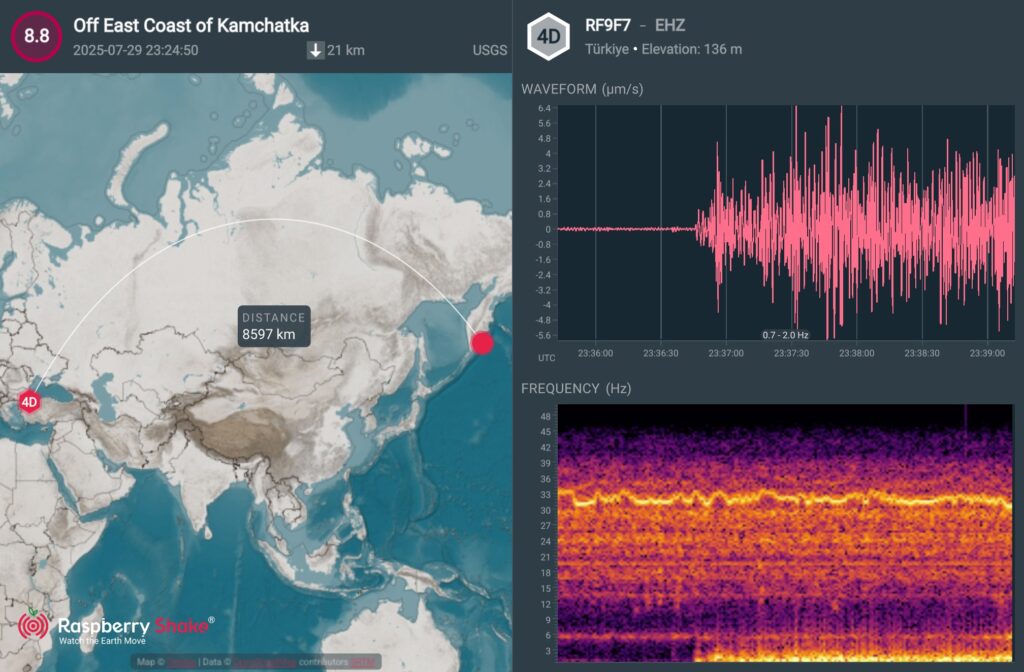⚠️ Tsunami Warnings Issued Across the Pacific
The earthquake struck at 8:25am JST (11:25 GMT), approximately 119 km southeast of Petropavlovsk-Kamchatsky, at a shallow depth of just 19.3 km. This shallow depth intensified its destructive power, triggering tsunami warnings and advisories in over a dozen countries including:
- Russia
- Japan
- Hawaii
- Taiwan
- The Philippines
- China
- Alaska
- California
- Mexico
- Peru
- Ecuador
- Guam
- Tonga
- British Columbia
- Costa Rica
- Oregon
- Washington
An 8.8 magnitude earthquake just struck Russia — sending prayers for everyone's safety and strength.
— CryptoWithYogesh (@Yogesh_355) July 30, 2025
🌊 #Tsunami alerts also active for Japan — please stay vigilant and follow official guidance.
This is serious. Stay safe, protect each other 🙏.#Tsunamiwarning pic.twitter.com/ygDLgyMft7
🔔 Tsunami Warning vs. Advisory:
- A warning signals a high threat with expected widespread flooding and strong waves.
- An advisory indicates dangerous coastal activity but generally with lower severity.
🌍 Where Have Tsunami Waves Already Hit?
- Severo-Kurilsk (Russia) was struck first with waves as high as 5 meters (16.4 ft), causing flooding at the port and fish processing facilities.
- Petropavlovsk-Kamchatsky declared a state of emergency. The city, home to 165,000, experienced strong structural shaking.
- Japan reported four to five rounds of tsunami waves, with wave heights growing from 20cm to 1.3 meters. Evacuation orders were issued for nearly two million residents.
- Hawaii experienced waves up to 1.7 meters, and flights in and out of Maui were cancelled.
- California’s Monterey recorded the first waves at 12:48am local time.
- Ecuador, Chile, and Peru are on high alert with projected waves up to 3 meters.

📸 Eyewitness Accounts & On-Ground Impact
Residents in Petropavlovsk-Kamchatsky described the quake lasting over three minutes, with buildings swaying violently. In Japan, footage from NHK showed citizens sheltering on rooftops and fishing boats leaving harbors to escape rising waters. The Fukushima nuclear plant was temporarily evacuated as a precaution.
📊 Why Did This Happen?
This earthquake occurred in the Pacific Ring of Fire, an active seismic zone. According to geologist Chris Elders, the Pacific Plate subducting beneath the Eurasian Plate caused the sudden seabed uplift, displacing large volumes of water and generating tsunami waves moving at jet-speed across the ocean.
🌐 Which Countries Are Safe?
- New Zealand reported no direct impact but warned citizens to avoid coastal areas due to possible strong surges.
- Australia was on the advisory list but later confirmed no threat to the mainland or offshore territories, according to the Bureau of Meteorology.
🧭 What Should You Do During a Tsunami Warning?
- Move to higher ground or inland immediately.
- Avoid beaches, harbors, rivers, and coastal roads.
- Stay tuned to local alerts via radio, sirens, or emergency messages.
- Do not return to low-lying areas until officials declare them safe — multiple waves can follow hours apart.
- Assist vulnerable individuals, including children, elderly, and those with disabilities
📢 Final Word
This disaster is a stark reminder of the unpredictable power of nature. While early warning systems have saved countless lives, preparedness remains key. Stay alert, follow official instructions, and prioritize safety over everything else.
_______________Next Story________________

